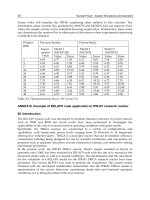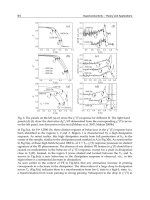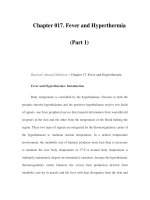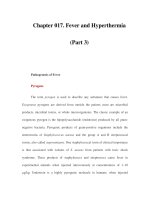Chapter 017. Fever and Hyperthermia (Part 4) potx
Bạn đang xem bản rút gọn của tài liệu. Xem và tải ngay bản đầy đủ của tài liệu tại đây (58.53 KB, 5 trang )
Chapter 017. Fever and Hyperthermia
(Part 4)
Chronology of events required for the induction of fever. AMP, adenosine
5'-monophosphate; IFN, interferon; IL, interleukin; PGE
2
, prostaglandin E
2
; TNF,
tumor necrosis factor.There are four receptors for PGE
2
, and each signals the cell
in different ways. Of the four receptors, the third (EP-3) is essential for fever:
when the gene for this receptor is deleted in mice, no fever follows the injection of
IL-1 or endotoxin. Deletion of the other PGE
2
receptor genes leaves the fever
mechanism intact. Although PGE
2
is essential for fever, it is not a
neurotransmitter. Rather, the release of PGE
2
from the brain side of the
hypothalamic endothelium triggers the PGE
2
receptor on glial cells, and this
stimulation results in the rapid release of cyclic adenosine 5'-monophosphate
(cyclic AMP), which is a neurotransmitter. As shown in Fig. 17-1, the release of
cyclic AMP from the glial cells activates neuronal endings from the
thermoregulatory center that extend into the area. The elevation of cyclic AMP is
thought to account for changes in the hypothalamic set point either directly or
indirectly (by inducing the release of neurotransmitters). Distinct receptors for
microbial products are located on the hypothalamic endothelium. These receptors
are called Toll-like receptors and are similar in many ways to IL-1 receptors. The
direct activation of Toll-like receptors also results in PGE
2
production and fever.
Production of Cytokines in the CNS
Several viral diseases produce active infection in the brain. Glial and
possibly neuronal cells synthesize IL-1, TNF, and IL-6. CNTF is also synthesized
by neural as well as neuronal cells. What role in the production of fever is played
by these cytokines produced in the brain itself? In experimental animals, the
concentrations of cytokine required to cause fever are several orders of magnitude
lower with direct injection into the brain than with IV injection. Therefore, CNS
production of these cytokines apparently can raise the hypothalamic set point,
bypassing the circumventricular organs involved in fever caused by circulating
cytokines. CNS cytokines may account for the hyperpyrexia of CNS hemorrhage,
trauma, or infection.[newpage]
APPROACH TO THE PATIENT: FEVER OR HYPERTHERMIA
Physical Examination
Attention must be paid to the chronology of events and to other signs and
symptoms preceding the fever. The temperature may be taken orally or rectally,
but the site used should be consistent. Axillary temperatures are notoriously
unreliable. Electronic devices for measuring tympanic membrane temperatures are
reliable and preferred over oral temperature measurements in patients with
pulmonary disease such as acute infection or asthma.
Laboratory Tests
The workup should include a complete blood count; a differential count
should be performed manually or with an instrument sensitive to the identification
of eosinophils, juvenile or band forms, toxic granulations, and Döhle bodies, the
last three of which are suggestive of bacterial infection. Neutropenia may be
present with some viral infections.
Measurement of circulating cytokines in patients with fever is of little use
since levels of pyrogenic cytokines in the circulation often are below the detection
limit of the assay or do not coincide with the fever. Although some studies have
shown correlations between circulating IL 6 levels and peak febrile elevations, the
most valuable measurements in patients with fever are C-reactive protein level and
erythrocyte sedimentation rate. These markers of pathologic processes are
particularly helpful in identifying disease in patients with small elevations in body
temperature.
Fever in Recipients of Anticytokine Therapy
As of this writing, more than 750,000 patients in the United States are
receiving chronic anticytokine therapy for Crohn's disease, rheumatoid arthritis, or
psoriasis. Does such therapy mask infection by preventing fever? With the
increasing use of anticytokines to reduce the activity of IL-1, IL-6, IL-12, and
TNF, the effect of these agents on the febrile response must be considered. The
blocking of cytokine activity has the distinct clinical drawback of lowering the
level of host defenses against both routine bacterial and opportunistic infections.
The opportunistic infections reported in patients given neutralizing antibodies to
TNF-α (infliximab or adalimumab) are similar to those reported in the HIV-1-
infected population (e.g., new infection with or reactivation of Mycobacterium
tuberculosis , with dissemination). A soluble receptor for TNF, etanercept, is also
associated with opportunistic infections but less so than the neutralizing
antibodies.
In nearly all reported cases of infection associated with anticytokine
therapy, fever is among the presenting signs. However, the extent to which the
febrile response is reduced in these patients remains unknown. Fever in a patient
who develops an infection during anticytokine treatment is likely to be due to the
direct action of microbial products on the hypothalamic thermoregulatory center,
with induction of PGE
2
. For example, blocking the activity of IL-1 or TNF during
experimental endotoxin-induced fever in volunteers does not affect the febrile
response.









